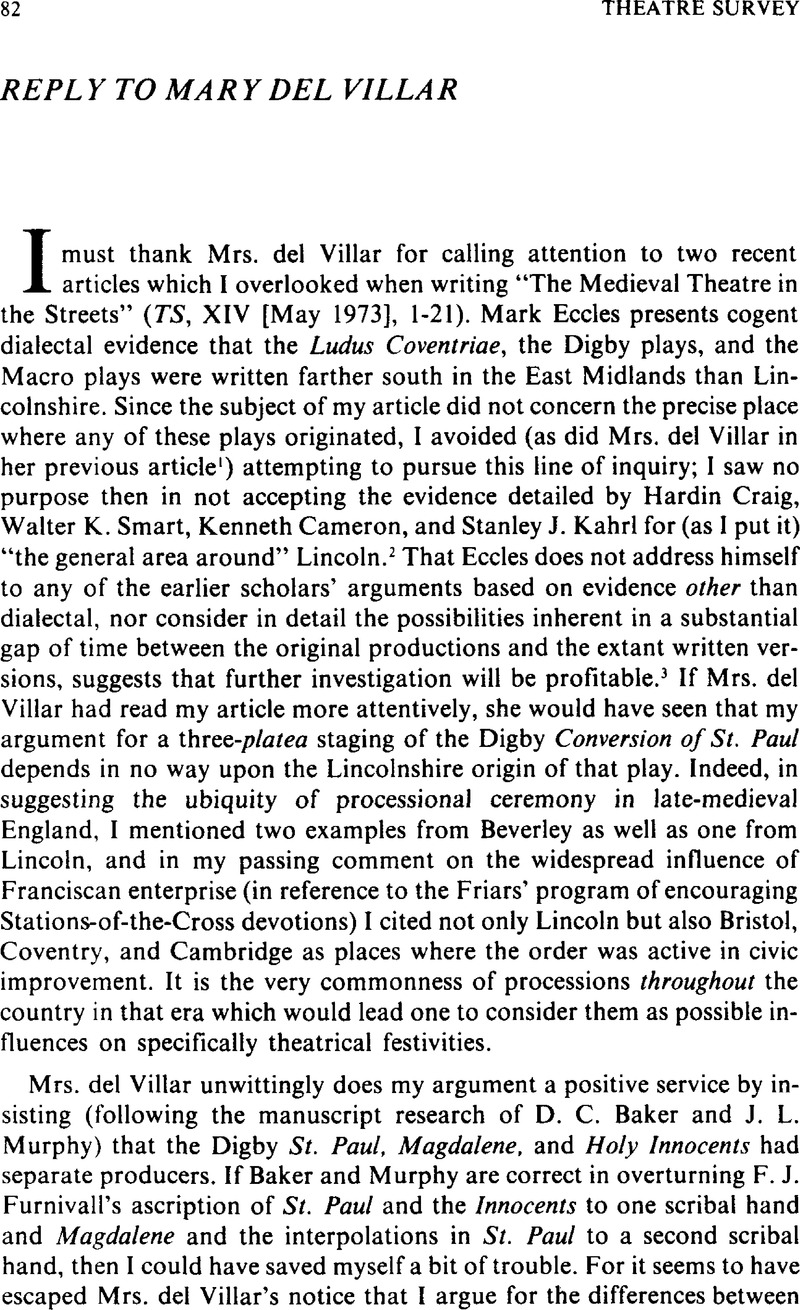No CrossRef data available.
Article contents
Reply to Mary Del Villar
Published online by Cambridge University Press: 07 July 2009
Abstract

- Type
- Notes and Comment
- Information
- Copyright
- Copyright © American Society for Theatre Research 1973
References
Notes
1 “The Staging of The Conversion of Saint Paul,” Theatre Notebook, XXV (1970–1971), 64–68Google Scholar.
2 Craig, English Religious Drama of the Middle Ages (Oxford, 1955), pp. 265–280, 310–7;Google Scholar Smart, “The Castle of Perseverance: Place, Date and a Source,” The Manly Anniversary Studies in Language and Literature (Chicago, 1923), pp. 42–53Google Scholar; Cameron, & Kahrl, , “The N-Town Plays at Lincoln,” Theatre Notebook, XX (1965–1966), 61–69Google Scholar.
3 Eccles' position in regard to the Ludus Coventriae is upheld by Nelson, Alan H., “On Recovering the Lost Norwich Corpus Christi Cycle,” Comparative Drama, IV (1970–1971), 241–252Google Scholar.
4 Though I overstated the similarity between Herod's vaunt in Magdalene and his vaunt in the Digby Innocents, it is nonetheless obvious that whoever wrote Magdalene had some Holy Innocents play in mind at that point. His vaunt in Magdalene, both in its situation and specific subject matter, fits far more logically—and with greater authority from dramatic tradition and the Bible—into the episodes following the Nativity than into those of Christ's public ministry.
5 And with which, upon re-reading, I agree more fully than ever, even to the point of wishing to retract my single former demurral—about her placing of the audience—which I see now resulted from a misunderstanding of her position on my part.
6 Mill, Anna Jean, Mediaeval Plays in Scotland (Edinburgh, 1927), p. 73Google Scholar (not p. 66, as cited by del Villar).
7 Del Villar, p. 67.
8 Not only generally, but specifically those reproduced by Wickham for the pas d'armes: Early English Stages 1300 to 1660 (London, 1959)Google Scholar, Fifield, I. Merle (“The Arena Theatres in Vienna Codices 2535 and 2536,” Comparative Drama, II [1968–1969], 259–282Google Scholar) reproduces seven miniatures by a Lowland artist from two codices of La Fortresse de la Foy. Even if one does not go all the way with her argument that the pictures of encircled “castles” are theatrically based in every major detail, one may still conclude from their shape, constant repetition, and frequent irrelevance to the exact matter of the allegory they purport to illustrate, either that some degree of theatrical inspiration lies directly behind them, or that they are examples of an illustrative tradition (see Kernodle, , From Art to Theatre [Chicago, 1944]Google Scholar, shared fully by the designer of The Castle of Perseverance.
9 Wickham, , “The Staging of Saint Plays in England,” The Medieval Drama, ed. Sticca, Sandro (Albany, 1972), pp. 106–111Google Scholar.
10 Fifield (see n. 8, above), in a capsule critique briefer than mine, points up the flaws in Southern's Castle reconstruction even more tellingly than I did. Her conclusions, based on new as well as familiar evidence, imply a Castle model rather close in all its essential features to the one I attempted in my sketch.




